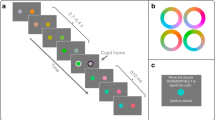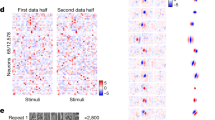Abstract
The visual system perceives objects as coherent even when some parts are hidden or discontinuous. How this representation is constructed from local features of many nearby objects is termed the 'binding problem.' Here we manipulate contrast in several drifting gratings that can be perceived as either independent objects or parts of a single object. Contrast modulations that are correlated in time enhance perceptual coherence, whereas uncorrelated modulations impair coherence. Presumably, correlated contrast modulations produce correlated responses in cortical neurons. Therefore, our results are consistent with the hypothesis that temporal correlation of neural activity is important for feature binding.
This is a preview of subscription content, access via your institution
Access options
Subscribe to this journal
Receive 12 print issues and online access
$209.00 per year
only $17.42 per issue
Buy this article
- Purchase on Springer Link
- Instant access to full article PDF
Prices may be subject to local taxes which are calculated during checkout



Similar content being viewed by others
References
Köhler, W. Gestalt psychology (Meridian Press, New York, 1947)
Van Essen, D.C., Anderson, C.H. & Felleman, D.J. Information processing in the primate visual system: an integrated systems perspective. Science 255, 419–423 (1992)
Zeki, S. A Vision of the brain. (Blackwell, Cambridge MA, 1993)
Hardcastle, V. Psychology's binding problem and possible neurobiological solutions. J. Consciousn. Studies 1, 66–90 ( 1994)
Damasio, A.R. The brain binds entities and events by multiregional activation from convergence zones . Neural Computation 1, 123– 132 (1989)
Milner, P.M. A model for visual shape recognition. Psychol. Rev. 81, 521–535 (1974)
von der Malsburg, C. in Brain Theory (eds Palm, G. & Aertsen, A.) 161– 176 (Springer, Berlin, 1986)
Singer, W. & Gray, C.M. Visual feature integration and the temporal correlation hypothesis. Annu. Rev. Neurosci. 18, 555–586 (1995)
Crick, F. & Koch, C. Towards a neurobiological theory of consciousness. Semin. Neurosci. 2, 263– 275 (1990)
Singer, W. Search for coherence: A basic principle of cortical self-organization. Concepts Neurosci. 1, 1–26 (1990 )
Eckhorn, R., Bauer, R., Jordan, W., Brosch, M. & Kruse, W. Coherent oscillations: a mechanism for feature linking in the visual cortex? Biol. Cybern. 60, 121–130 (1988)
Lorenceau, J. & Shiffrar, M. The influence of terminators on motion integration across space. Vision Res. 32, 263–273 (1992)
Alais, D., van der Smagt, M.J., van den Berg, A.V. & van de Grind, W.A. Local and global factors affecting the coherent motion of gratings presented in multiple apertures. Vision Res. (in press)
Bodis-Wollner, I., Hendley, C.D., & Kulikowski, J.J. Electrophysiological and psychophysical responses to modulation of contrast of a grating pattern. Perception 1, 341–349 (1972)
Enroth-Cugell, C. & Robson, J.G. The contrast sensitivity of retinal ganglion cells in the cat. J. Physiol. 187, 517–522 (1966)
Troy, J.B. & Enroth-Cugell, C. X and Y ganglion cells inform the cat's brain about contrast in the retinal image. Exp. Brain Res. 93, 383–399 ( 1993)
Hamilton, D.B. Albrecht, D.G. & Geisler, W S. Visual cortical receptive fields in monkey and cat: spatial and temporal phase transfer function. Vision Res. 29 , 1285–1308 (1989)
Chubb, C. & Sperling, G. Two motion perception mechanisms revealed through distance-driven reversal of apparent motion. Proc. Natl. Acad. Sci. USA 86, 2985– 2989 (1989)
Cavanagh, P. & Mather, G. Motion: the long and the short of it. Spatial Vision 4, 103– 129 (1989)
Smith, A.T. & Ledgeway, T. Sensitivity to second-order motion as a function of temporal frequency and eccentricity. Vision Res. 38, 403–410 ( 1998)
Adelson, E.H. & Movshon, J.A. Phenomenal coherence of moving visual patterns. Nature 300, 523– 525 (1982)
Fahle, M. & Koch, C. Spatial displacement, not temporal asynchrony, destroys figural binding. Vision Res. 35 , 491–494 (1995)
Kiper, D.C., Gegenfurtner, K.R. & Movshon, J.A. Cortical oscillatory responses do not affect visual segmentation . Vision Res. 36, 539–544 (1996)
Leonards, U., Singer, W. & Fahle, M. The influence of temporal phase differences on texture segmentation. Vision Res. 36, 2689–2697 (1996)
Fahle, M. Figure-ground discrimination from temporal information. Proc. R. Soc. Lond. B , 254, 199–203 ( 1993)
Kojima, H. Figure/ground segregation from temporal delay is best at high spatial frequencies. Vision Res. (in press)
Gilbert, C.D. Horizontal integration and cortical dynamics. Neuron 9, 1–13 (1992)
Blake, R. & Yang, Y. Spatial and temporal coherence in perceptual binding. Proc. Natl. Acad. Sci. USA 94, 7115–7119 (1997)
Brainard, D.H. The psychophysics toolbox. Spatial Vision 10, 443– 446 (1997)
Acknowledgements
We thank Haruyuki Kojima, Jeffrey Schall, George Sperling and Zhong-Lin Lu for helpful discussion. This work is supported by the US National Institutes of Health.
Author information
Authors and Affiliations
Corresponding author
Rights and permissions
About this article
Cite this article
Alais, D., Blake, R. & Lee, SH. Visual features that vary together over time group together over space . Nat Neurosci 1, 160–164 (1998). https://doi.org/10.1038/414
Received:
Accepted:
Issue Date:
DOI: https://doi.org/10.1038/414
This article is cited by
-
Capturing the objects of vision with neural networks
Nature Human Behaviour (2021)
-
Interaction dynamics between grouping principles in touch: phenomenological and psychophysical evidence
Psychological Research (2019)
-
Visual psychophysics: synchrony in motion
Nature Neuroscience (1998)



